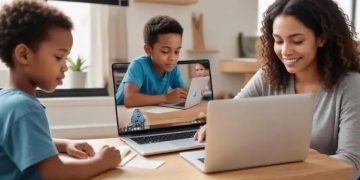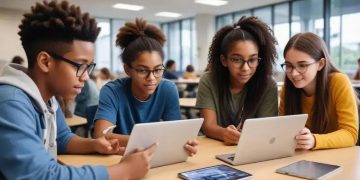Screen Time vs Book Time: Unlocking Preschool Learning Potential

In the digital era, parents face a crucial challenge: balancing screen time and book time for preschool readiness. How can we leverage technology while ensuring our children develop critical cognitive skills through traditional reading experiences?
Understanding screen time impact on early childhood
Screen time has become an increasingly prevalent aspect of early childhood development, with significant implications for cognitive, social, and emotional growth. Research indicates that excessive digital exposure can potentially alter brain development in young children, affecting attention spans, language acquisition, and social interaction skills.
Young children are particularly vulnerable to the effects of digital media. Studies suggest that children under five who spend more than two hours daily on screens may experience delayed language development, reduced creative play, and decreased opportunities for critical social-emotional learning.
Neurological Considerations of Screen Time
The rapid visual stimulation from digital devices can overstimulate a child’s developing brain, potentially disrupting natural neural pathways. Excessive screen time can impact executive functioning skills, including impulse control, working memory, and cognitive flexibility.
Different types of screen content produce varying developmental impacts. Educational, interactive content supervised by parents can offer some learning benefits, while passive, non-interactive media tends to be less beneficial for cognitive development.
Social and Emotional Development Risks
Prolonged screen time can reduce face-to-face interactions crucial for emotional intelligence and communication skill development. Children learn empathy, social cues, and emotional regulation primarily through direct human interactions, which digital devices cannot fully replicate.
Pediatric experts recommend creating a balanced approach to digital media consumption, emphasizing quality over quantity and maintaining strict age-appropriate guidelines for screen exposure.
The cognitive benefits of traditional book reading
Traditional book reading offers profound cognitive advantages for preschool children, far beyond simple entertainment. Physical books engage multiple sensory pathways that digital experiences cannot replicate, stimulating brain development in unique and complex ways.
Language acquisition accelerates through direct interaction with printed materials. Children who are regularly read to develop richer vocabularies, stronger comprehension skills, and enhanced listening abilities compared to those with limited book exposure.
Neurological Stimulation through Reading
Reading physical books activates critical brain regions responsible for imagination, empathy, and sequential thinking. The tactile experience of turning pages and observing illustrations creates neural connections that support cognitive flexibility and creative problem-solving skills.
Research demonstrates that children who engage with traditional books develop superior narrative understanding, allowing them to construct more sophisticated mental representations of stories and characters.
Emotional Intelligence Development
Book reading serves as a critical platform for emotional learning. Through stories, children explore complex feelings, understand different perspectives, and develop crucial social-emotional skills that digital media often cannot provide.
Interactive reading moments between parents and children foster deeper emotional bonds, creating safe spaces for discussing feelings, exploring scenarios, and building communication foundations that extend far beyond literacy skills.
Finding the right balance between digital and print media
Achieving a harmonious balance between digital and print media requires strategic planning and mindful parental guidance. Modern childhood development demands a nuanced approach that leverages the strengths of both technological and traditional learning resources.
Parents can establish effective media consumption guidelines by implementing structured, age-appropriate boundaries that prioritize educational quality over screen time quantity.
Establishing Healthy Media Consumption Ratios
Experts recommend a strategic 1:3 ratio of digital to print media interactions for preschool-aged children. This means for every 15 minutes of digital engagement, children should spend approximately 45 minutes with physical books, interactive play, or direct human communication.
Digital tools can complement traditional learning when carefully selected. Educational apps and interactive digital platforms can reinforce learning concepts introduced through books, creating a synergistic educational experience.
Quality Over Quantity
Not all media consumption is equivalent. High-quality, educational content should take precedence over passive entertainment. Interactive digital platforms that encourage problem-solving, creativity, and critical thinking can be valuable when used in moderation.
Parents should actively participate in both digital and print media experiences, transforming screen time and reading sessions into collaborative, engaging learning opportunities that promote cognitive and social development.
Age-appropriate screen time guidelines for preschoolers
Navigating screen time recommendations for preschoolers requires careful consideration of developmental stages and individual learning needs. Pediatric experts provide nuanced guidelines to support healthy cognitive and social development during these critical early years.
The American Academy of Pediatrics suggests specific screen time parameters that evolve with a child’s age and developmental milestones.
Developmental Stage-Based Recommendations
Children under 18 months should avoid digital media except for video chatting with family. For children 18-24 months, high-quality educational content with parental interaction is acceptable. Ages 2-5 years can engage with up to 1 hour of educational programming daily, prioritizing interactive and learning-focused content.
Quality trumps quantity when considering screen exposure. Parents should focus on educational, age-appropriate content that promotes learning and social interaction.
Monitoring and Implementing Screen Time Limits
Effective screen time management involves creating structured media consumption routines. Use parental controls, establish consistent viewing times, and actively engage with children during digital interactions. Rotate between digital and non-digital activities to maintain a balanced developmental approach.
Interactive digital experiences that encourage problem-solving, creativity, and learning can be valuable when carefully selected and supervised by caregivers.
Interactive reading strategies to enhance learning

Interactive reading strategies transform traditional book experiences into dynamic learning opportunities for preschoolers. Engaging children actively during reading sessions can significantly enhance comprehension, vocabulary, and cognitive development.
Parents and educators can implement multiple techniques to make reading more interactive and stimulating for young learners.
Questioning and Prediction Techniques
Stop periodically during reading to ask open-ended questions about the story’s characters, potential plot developments, and emotional context. Encourage children to predict what might happen next, which stimulates critical thinking and imagination. These strategies help children develop narrative understanding and analytical skills.
Use visual cues in illustrations to prompt discussions about story elements, character emotions, and potential story outcomes.
Multisensory Reading Approaches
Incorporate physical actions, voices, and dramatic interpretations while reading. Use different character voices, act out story scenes, and invite children to mimic movements or sounds. This approach transforms reading from a passive to an active learning experience, enhancing memory retention and engagement.
Utilize props, puppets, or interactive storytelling techniques that allow children to participate directly in the narrative, making reading a collaborative and immersive experience.
Digital tools that support early childhood education
Digital tools have emerged as powerful educational resources that can complement traditional learning approaches for young children. Carefully selected technology offers interactive and engaging educational experiences that support cognitive development and skill acquisition.
Modern educational platforms provide age-appropriate digital solutions designed specifically for early childhood learning needs.
Educational Applications and Learning Platforms
Interactive learning apps can target specific developmental skills such as basic mathematics, language comprehension, problem-solving, and motor skill coordination. Applications like ABCmouse, PBS Kids Games, and Khan Academy Kids provide structured, engaging content that adapts to individual learning paces and interests.
These digital tools often incorporate gamification techniques that make learning feel like play, increasing motivation and knowledge retention.
Adaptive Learning Technologies
Advanced digital platforms use artificial intelligence to personalize learning experiences. These technologies track a child’s progress, identify learning gaps, and dynamically adjust content difficulty. Adaptive learning systems ensure that educational content remains challenging yet achievable, preventing frustration and maintaining learner engagement.
Parental monitoring features allow adults to track educational progress, understand learning patterns, and provide targeted support in specific skill development areas.
Measuring developmental milestones in the digital age
Tracking child development has evolved with technological innovations, providing parents and educators more precise tools for monitoring cognitive, social, and emotional growth. Digital platforms now offer comprehensive tracking mechanisms that go beyond traditional assessment methods.
Modern developmental milestone tracking integrates multiple data points to create holistic progress evaluations.
Technology-Enhanced Assessment Tools
Digital screening applications utilize adaptive algorithms to assess children’s developmental progress across multiple domains. These tools can identify potential learning challenges, communication delays, and cognitive development patterns with unprecedented accuracy. Platforms like Developmental Check and Milestone Tracker provide parents with detailed insights into their child’s growth trajectory.
Advanced assessment technologies consider individual variations, avoiding one-size-fits-all developmental benchmarks.
Comprehensive Progress Monitoring
Innovative tracking systems combine quantitative measurements with qualitative observations, creating nuanced developmental profiles. These digital tools integrate input from parents, educators, and healthcare professionals, providing a 360-degree view of a child’s developmental journey.
Machine learning algorithms help predict potential developmental areas requiring additional support, enabling early intervention strategies.
Creating a holistic learning environment at home
Designing a comprehensive learning environment at home requires strategic integration of digital and traditional educational resources. Balanced learning spaces support cognitive, emotional, and social development for preschool children across multiple domains.
Intentional home learning environments blend technology, interactive play, and structured educational experiences.
Physical Space Design
Create dedicated learning zones that separate digital interactions from hands-on learning activities. Arrange spaces with accessible educational materials, comfortable reading corners, and designated areas for digital engagement. Incorporate versatile furniture that supports multiple learning modes, such as adjustable tables and interactive display surfaces.
Ensure learning spaces are well-lit, organized, and stimulate curiosity through visual and tactile elements.
Integrated Learning Approaches
Develop flexible learning routines that seamlessly combine digital tools and traditional educational methods. Alternate between screen-based educational apps, interactive reading sessions, creative play, and physical activities. Use technology as a supportive tool rather than a primary learning mechanism, maintaining a balanced approach to skill development.
Parents should actively participate in learning experiences, transforming home environments into dynamic educational ecosystems.
Balancing Screen Time and Book Time: A Path to Preschool Success
Navigating the digital landscape of early childhood education requires thoughtful, intentional strategies that prioritize holistic child development. By understanding the nuanced roles of both digital and traditional learning tools, parents can create rich, supportive environments that foster cognitive, social, and emotional growth.
The key lies not in choosing between screen time and book time, but in finding a harmonious integration that maximizes learning potential. Educational technologies and traditional reading experiences each offer unique benefits that, when balanced carefully, can significantly enhance a child’s developmental journey.
As technology continues to evolve, parents and educators must remain adaptable, continuously reassessing screen time guidelines, interactive learning strategies, and developmental milestone tracking. The goal is to empower preschoolers with diverse, engaging learning experiences that prepare them for an increasingly digital world while preserving the irreplaceable value of human interaction and imagination.





